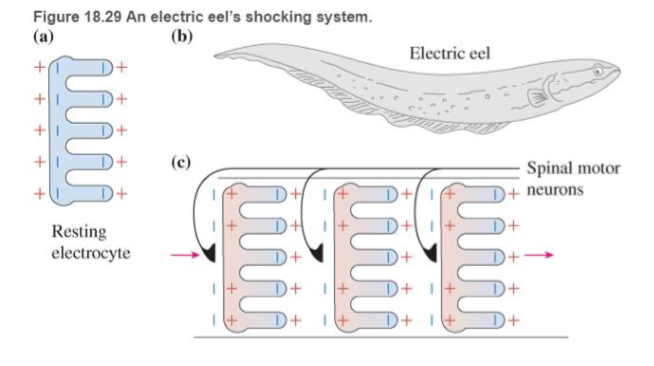
Concept explainers
BIO Electric discharge by eels In several aquatic animals such as the South American electric eel electric organs produce 600-V potential difference pulses to ward off predators as well as to stun prey Figure 18.29 illustrates the key component that produces this electric shock—an electrolyte. The interior of an inactive electrolyte (Figure 18.29a) has an excess of negatively charged ions. The exterior has an excess of positively charged sodium ions

The eel's long trunk and tail contain many electrolytes placed one after the other in columns (Figures 18.29b and c). Each electrolyte contains several types of ion channels, which when activated by a nerve impulse allow sodium ions to pass through channels on the loft flat side of each electrolyte from outside the cell to the inside. This causes the electric potential across that cell membrane to change from
Suppose that one cell of the electrolyte is regarded as a small capacitor with a 0.10-V potential difference across it How should we arrange 10 cells to get a 1.0-V potential difference across them?
a. in series, as in Figure P18.64a
b. in parallel, as in Figure P18.64b
c. randomly so that they do not cancel each other d not enough information
Want to see the full answer?
Check out a sample textbook solution
Chapter 18 Solutions
College Physics
Additional Science Textbook Solutions
College Physics: A Strategic Approach (3rd Edition)
Anatomy & Physiology (6th Edition)
Microbiology: An Introduction
Human Physiology: An Integrated Approach (8th Edition)
Campbell Biology (11th Edition)
Cosmic Perspective Fundamentals
- Help me make a visualize experimental setup using a word document. For the theory below.arrow_forwardHow to solve this, given answerarrow_forwardThree point-like charges are placed at the corners of a square as shown in the figure, 28.0 cm on each side. Find the minimum amount of work required by an external force to move the charge q1 to infinity. Let q1=-2.10 μC, q2=+2.40 μС, q3=+3.60 μC.arrow_forward
- A point charge of -4.00 nC is at the origin, and a second point charge of 6.00 nC is on the x axis at x= 0.820 mm . Find the magnitude and direction of the electric field at each of the following points on the x axis. x2 = 19.0 cmarrow_forwardFour point-like charges are placed as shown in the figure, three of them are at the corners and one at the center of a square, 36.0 cm on each side. What is the electric potential at the empty corner? Let q1=q3=+26.0 µС, q2=-28.0 μC, and q4=-48.0μc Varrow_forwardPLS HELparrow_forward
 College PhysicsPhysicsISBN:9781938168000Author:Paul Peter Urone, Roger HinrichsPublisher:OpenStax College
College PhysicsPhysicsISBN:9781938168000Author:Paul Peter Urone, Roger HinrichsPublisher:OpenStax College Principles of Physics: A Calculus-Based TextPhysicsISBN:9781133104261Author:Raymond A. Serway, John W. JewettPublisher:Cengage Learning
Principles of Physics: A Calculus-Based TextPhysicsISBN:9781133104261Author:Raymond A. Serway, John W. JewettPublisher:Cengage Learning Physics for Scientists and EngineersPhysicsISBN:9781337553278Author:Raymond A. Serway, John W. JewettPublisher:Cengage Learning
Physics for Scientists and EngineersPhysicsISBN:9781337553278Author:Raymond A. Serway, John W. JewettPublisher:Cengage Learning Physics for Scientists and Engineers with Modern ...PhysicsISBN:9781337553292Author:Raymond A. Serway, John W. JewettPublisher:Cengage Learning
Physics for Scientists and Engineers with Modern ...PhysicsISBN:9781337553292Author:Raymond A. Serway, John W. JewettPublisher:Cengage Learning College PhysicsPhysicsISBN:9781305952300Author:Raymond A. Serway, Chris VuillePublisher:Cengage Learning
College PhysicsPhysicsISBN:9781305952300Author:Raymond A. Serway, Chris VuillePublisher:Cengage Learning Physics for Scientists and Engineers, Technology ...PhysicsISBN:9781305116399Author:Raymond A. Serway, John W. JewettPublisher:Cengage Learning
Physics for Scientists and Engineers, Technology ...PhysicsISBN:9781305116399Author:Raymond A. Serway, John W. JewettPublisher:Cengage Learning





